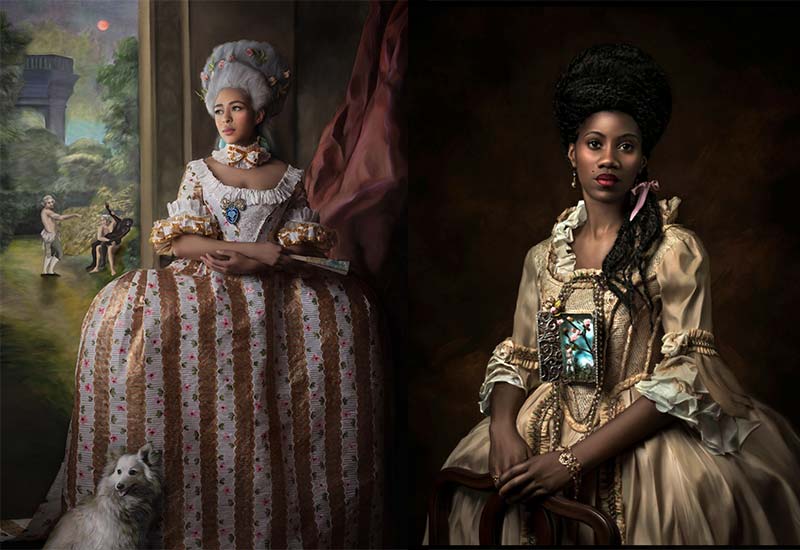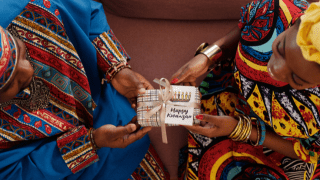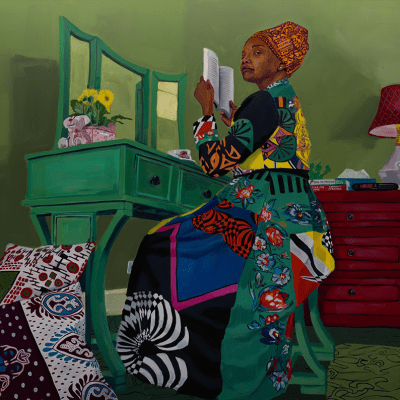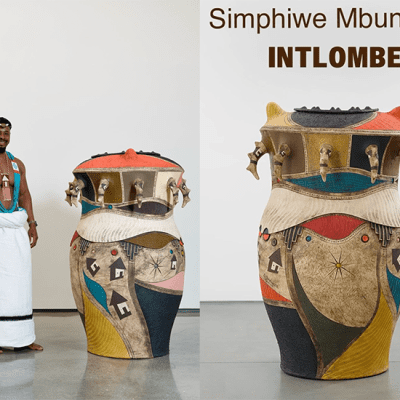Through her graceful body of work, New York-based artist Fabiola Jean-Louis is Rewriting History. By manipulating photographs, Jean-Louis’s latest series allows us to visualize what fine art between the 15th–19th centuries (typically dominated by White European royalty) would look like through the lens of the black experience.
Having a strong appreciation for period ball gowns, Jean-Louis would spend countless hours in the Old Master painting section of museum galleries. When she noticed that there was a complete absence of black women, the Haitian-born artist sought to introduce the black and brown body into a space that was previously reserved for whiteness, while also combining aspects from modern-day society. Additionally, Rewriting History was inspired by a desire to start imperative conversations about history, the harrowing treatment of black bodies, and the value of black lives. “The series speaks to the shocking treatment of Blacks throughout history and the trauma inflicted on their bodies as juxtaposed with the abstract idea of black freedom,” Jean-Louis wrote in a statement about the series. “Simultaneously, it engages with a vision of the future—one of hope, resilience, and justice.”
For a first-time observer, the photographs within Rewriting History could easily be mistaken for oil paintings. From the softness and delicacy of the models to the classical backgrounds, Jean-Louis’s use of painterly photography permits us to experience fine art from the past, reimagined with the black female body.
Of course, there’s more to the process behind the remarkable work than what meets the eye. Not only did Jean-Louis photograph the series, but she also created the European-style gowns that each model elegantly wears, crafted with paper. The use of paper gown sculptures adds to the delicacy within the series. “I work with paper because I’m truly in love and obsessed with paper,” she explained. “I love its strength, I love its fragility. I love that there’s no real mistakes. When I’m working with it, I can discover new things about the process. I have to have a very certain type of technique to work with something that’s so fragile. I also have to learn about letting go, because I’m working with a material that is not going to last forever. Paper also symbolizes decay for me, because I’m always talking about that in my work as well.”
Moreover, the process of layering was another concept within the series that Jean-Louis wished to explore. “The materials used for the paper gown sculptures are transformed in a way that allows me to represent layers of time and the events of the past as they intrude upon the present,” Jean-Louis said.

Left to Right: “Rest In Peace” and “Madame Beauvoir’s Painting” by Fabiola Jean-LouisAt its surface, the photographs are gentle, highlighting stunning black women in extravagant gowns and accessories. And yet, there are horrifying details embedded within each picture that represent the brutal mistreatment of black bodies, serving as a heavy reminder about our agonizing history. In Rest In Peace, for example, a chained black body hanging from a tree is present. Pink roses fill the otherwise bare branches, and a tombstone lies adjacent to the murdered. The unsettling image resides on the classical gown, near the heart, adorned with pearls and other jewelry. In another, Madame Beauvoir’s Painting, a black woman observes a painting of a black man, his back bloody and bruised from being lashed. His pain and suffering is carried on in the woman’s dress, which is embroidered with marks that symbolize remembering.
In an exclusive interview with My Modern Met, Jean-Louis described why she chose to juxtapose beauty and grace with the violence and cruelty of the past. “It is nothing for the news to splash our bloody, dead bodies on the screen for all to see. And seeing that does something to the human mind. It starts getting used to it,” she said. “Because of that, I chose to let beauty be the vehicle that I would carry those ugly truths in. I wanted all the details to symbolize all the intricacies of our existence and history. I also wanted to bring the viewer in, to feel comfortable—at least long enough to carry them to that hard place.”
“Through the materials, I suggest that although we cannot change the past, we can act to change the present, as we activate the memories, visions, and legacies of our ancestors,” Jean-Lewis said. “Rewriting History seeks to reconnect viewers to the past so that parallels with current events are amplified.”
Works from Fabiola Jean-Louis’s Rewriting History series are currently on display at the Brooklyn Creative Center (BRIC) until April 29. For more information about Jean-Louis and her artwork, visit her website.









